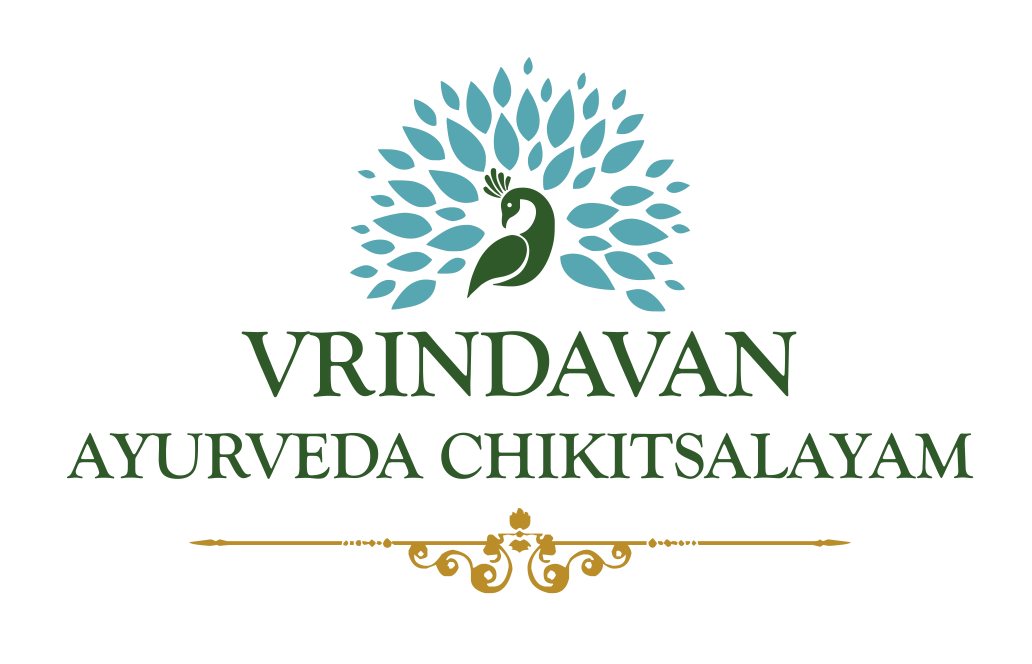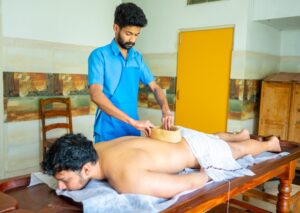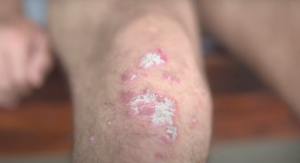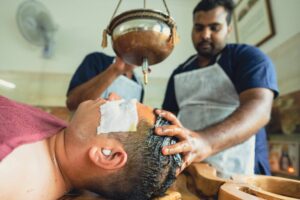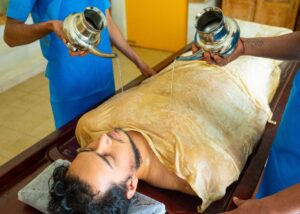Osteoarthritis is the most common form of arthritis that affects the Joints due to wearing down of the cartilage (protective tissue at the ends of bones). It causes pain, swelling, stiffness, and limited range of motion.

An Ayurvedic approach to Osteoarthritis treatment
As per Ayurveda, osteoarthritis resembles Sandhigatavata. Sandhigatavata is one such disease in which the vitiated vata localizes in the asthi sandhis (Joints bone) of the body causing gradual degeneration of joints. It is common in elderly people due to the progression of Vata Dosha as the age of the person advances towards old age. Females are more prone to this condition & the severity of pain is higher in weight-bearing joints such as the back, knee, & hip.
The Vata Dosha is aggravated in the body due to faulty diet & lifestyle, over-exertion, injury, suppression of natural urges, etc. The nature of Vata is rooksha (dry). When Vata gets vitiated, it dries up the lubricating synovial fluid inside the joint capsule, causing degeneration of the joints and cartilage.
Ayurvedic treatment for Osteoarthritis
In Ayurveda, the treatment of Sandhigatavata is aimed at reducing the Vata Dosha and increasing the Shleshaka Kapha (synovial fluid) so that the joint spaces are adequately lubricated for the free movement of joints.

The Ayurvedic formulations to treat osteoarthritis are Agni-promoting and Shrotoshodak herbs (channel-purifying). This helps to relieve pain, swelling of joints, and stiffness, & pacify Dosha disorder by removing Shrotoavarodhas (blockage of channels).
We at Vaidyaratnam Vrindavan Ayurveda Chikitsalayam provide anti-arthritic, anti-inflammatory herbal treatment along with physiotherapeutic & rehabilitative therapies.
The natural treatment for osteoarthritis helps to prevent the progression of the disease, rejuvenates damaged cartilage, relieves pain, and improves joint lubrication, function & strength.
Ayurvedic procedures in osteoarthritis treatment
The osteoarthritis knee treatment in Ayurveda also aims at performing procedures like Panchakarma for detoxification and rejuvenation.
Application of medicated paste or powder: Medicated herbal paste or powder may be applied externally in the acute stage to alleviate swelling, pain, and burning sensation.
Snehana (oleation): Administration of ghee or oils infused with bitter and astringent herbs.
Rasayana therapy (Rasayana Therapy): The rejuvenating herbal formulations and procedures to restore and rejuvenate the Asthi (bone) that.
Swedana(fomentation therapy): This therapy improves the flexibility of the joints and helps in clearing up any blockage in the subtle channels of the body.
Virechana (medicated purgation therapy): Virechana cleanses the body by removing the toxins from the body and also helps to restore the Agni (Digestive fire) in the body.
Basti (Medicated enema): These procedures are beneficial in pacifying aggravated Vata Dosha.
Herbs for arthritis management: The various herbs mentioned in the Ayurvedic text are considered the best Ayurvedic treatment for knee or joint pain. These are Boswelia serrata (Sallaki), Tinospora cordifolia (Guloochi), Strychnos nuxvomica (vishamushti), Commiphora mukul (Guggul), etc.
Some home remedies for osteoarthritis
- Applying a hot water bag or steam is helpful to reduce pain.
- The application of warm oil is helpful in non-inflammatory conditions.
- Local application of paste prepared from moringa leaves, tamarind leaves, and salt helps reduce inflammation.
- Maintaining a healthy weight and moderate exercise is beneficial concerning pain and function.
- Avoiding activities that overload the joint and walk for at least thirty minutes every day.
Diet for osteoarthritis
Making changes to the lifestyle and food choices (wholesome diet and regimen) are the key modalities of prevention and management of diseases in Ayurveda.
- Include lots of vegetables in the diet. Food should be freshly cooked and served hot.
- Soups of lentils and pulses should be taken by adding ginger and black pepper.
- Ghee and Oils should be taken in moderate quantities as they provide the lubrication to the joints
- Avoid eating foods that are dry or cold, sour, fried and pungent.
- Prepare your meals with rock salt (Sandhwa salt) and spices that are known to pacify Vata dosha.
- Eat a wholesome and nutrient-rich diet.
Yoga and Exercise for Osteoarthritis
The patients having affliction with osteoarthritis should do regular moderate exercise like yoga poses, breathing techniques and meditation. This helps the joint to function properly, reduce tension and improve joint flexibility.
Osteoarthritis is the most common form of arthritis that affects the Joints due to wearing down of the cartilage (protective tissue at the ends of bones). It causes pain, swelling, stiffness and limited range of motion.
An Ayurvedic approach to Osteoarthritis treatment
As per Ayurveda, osteoarthritis resembles Sandhigatavata. Sandhigatavata is one such disease in which the vitiated vata localizes in the asthi sandhis (Joints bone) of the body causing gradual degeneration of joints. It is common in the elderly people due to the progression of Vata Dosha as the age of the person advances towards old age. Females are more prone to this condition & the severity of pain is more in weight-bearing joints such as back, knee, & hip.
The Vata Dosha is aggravated in body due to faulty diet & lifestyle, over exertion, injury, suppression of natural urges etc. The nature of Vata is rooksha (dry). When Vata gets vitiated, it dries up the lubricating synovial fluid inside the joint capsule, causing degeneration of the joints and cartilage.
Ayurvedic treatment for Osteoarthrits
In Ayurveda, the treatment of Sandhigatavata is aimed at reducing the Vata Dosha and to increase the Shleshaka Kapha (synovial fluid) so that the joint spaces are adequately lubricated for the free movement of joints.
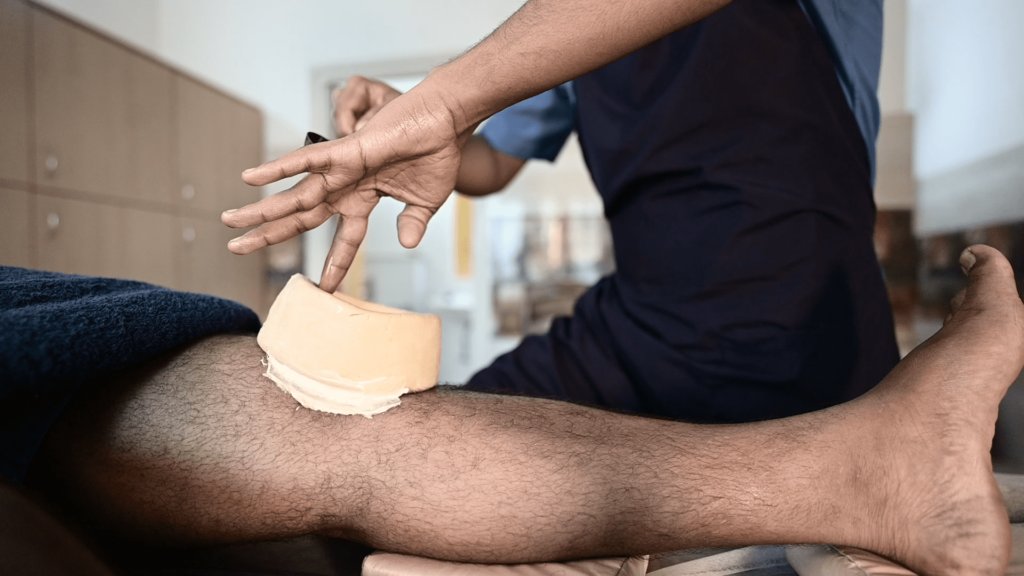
The Ayurvedic formulations to treat osteoarthritis are Agni-promoting and Shrotoshodak herbs (channel-purifying). This helps to relieve pain, swelling of joints, stiffness, & pacify Dosha disorder by removing Shrotoavarodhas (blockage of channels).
We at Vaidyaratnam Vrindavan Ayurveda Chikitsalayam provide anti-arthritic, anti-inflammatory herbal treatment along with physiotherapeutic & rehabilitative therapies.
The natural treatment for osteoarthritis helps to prevent the progression of the disease, rejuvenates damaged cartilages, relieves pain, and improves the joint lubrication, function & strength.
Ayurvedic procedures in osteoarthritis treatment
The osteoarthritis knee treatment in Ayurveda also aims at performing procedures like Panchakarma for detoxification and rejuvenation.
Application of medicated paste or powder: Medicated herbal paste or powder may be applied externally in the acute stage to alleviate swelling, pain and burning sensation.
Snehana (oleation): Administration of ghee or oils infused with bitter and astringent herbs.
Rasayana therapy (Rasayana Therapy): The rejuvenating herbal formulations and procedures to restore and rejuvenate the Asthi (bone) dhatu.
Swedana(fomentation therapy): This therapy improves the flexibility of the joints and helps in clearing up any blockage in the subtle channels of the body.
Virechana (medicated purgation therapy): Virechana cleanses the body by removing the toxins from the body and also helps to restore the Agni (Digestive fire) in the body.
Basti (Medicated enema): These procedures are beneficial in pacifying aggravated Vata Dosha.
Herbs for arthritis management: The various herbs mentioned in Ayurvedic text considering best Ayurvedic treatment for knee or joint pain. These are Boswelia serrata (Sallaki), Tinospora cordifolia (Guloochi), Strychnos nuxvomica (vishamushti), Commiphora mukul (Guggul), etc.
Some home remedies for osteoarthritis
- Applying hot water bag or steam is helpful to reduce pain.
- Application of warm oil is helpful in non inflammatory conditions.
- Local application of paste prepared from moringa leaves, tamarind leaves and salt is helpful to reduce inflammation.
- Maintaining healthy weight and moderate exercise is beneficial with respect to pain and function.
- Avoiding activities that overload the joint and walk for at least thirty minutes every day.
Diet for osteoarthritis
Making changes to the lifestyle and food choices (wholesome diet and regimen) are the key modalities of prevention and management of diseases in Ayurveda.

- Include lots of vegetables in the diet. Food should be freshly cooked and served hot.
- Soups of lentils and pulses should be taken by adding ginger and black pepper.
- Ghee and Oils should be taken in moderate quantities as they provide the lubrication to the joints
- Avoid eating foods that are dry or cold, sour, fried and pungent.
- Prepare your meals with rock salt (Sandhwa salt) and spices that are known to pacify Vata dosha.
- Eat a wholesome and nutrient-rich diet.
Yoga and Exercise for Osteoarthritis

The patients having affliction with osteoarthritis should do regular moderate exercise like yoga poses, breathing techniques and meditation. This helps the joint to function properly, reduce tension and improve joint flexibility.
